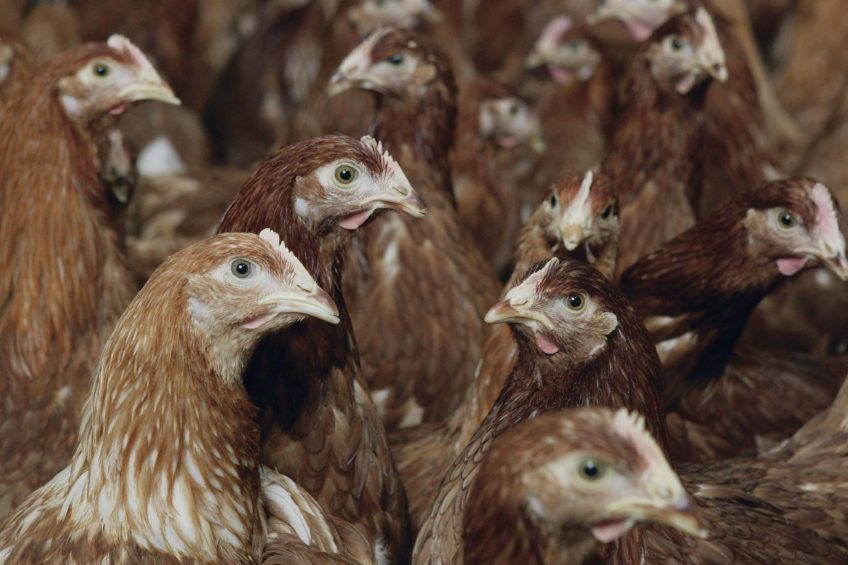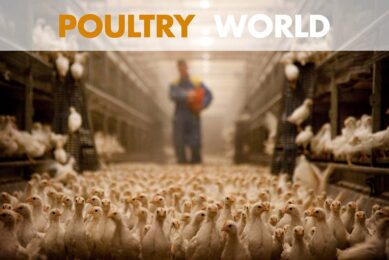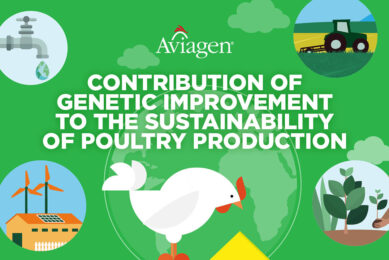Genome-wide selection in poultry

Genomic selection has the theoretical potential to further improve the effectiveness of breeding. Now, company-owned SNP-chips are being utilised in both layer and broiler breeding for this purpose. The focus is on shortening the generation interval, and selecting for specific traits. Testing birds under field conditions will remain necessary for achieving optimal breeding results.
By Prof. Dr. Rudolf Preisinger, Lohmann Tierzucht, Cuxhaven, Germany
Feeding the world’s growing population with high-quality food is the core aim of agricultural production. In view of the growing world population, this challenge will continuously become larger, especially in the big cities of developing countries where increases of 80 million annually are expected.
The production of eggs in these regions will be of increasing importance as they provide a relatively cheap source of animal protein. In contrast to poultry meat, which is traded between continents in large volumes, eggs are produced typically for consumption within the region, and only in Europe are traded across borders in significant volumes. In addition to conventional selection criteria like egg production, feed conversion and egg quality, traits related to animal welfare have become more important, particularly in Europe and North America. Very costly data recording is required to improve these traits. Novel recording systems have to be developed to test chickens in non-cage environments and husbandry systems accepted by welfare legislation.
Enhancement of progress
Continued genetic progress can be expected within the available gene pool of highly efficient white egg and brown egg lines, based on conventional selection on key traits. However, the laws of diminishing returns also apply in poultry breeding, and efforts to optimize performance testing, selection and reproduction have to be intensified to assure competitive rates of progress. Incorporating additional traits in the complex breeding goal and selection routine will automatically increase the total cost of data recording and lower the rate of progress for all other traits, without generating a measurable return on investment for the breeding company. They are therefore challenged to look for more precise, quicker and/or less expensive methods to evaluate individual and family differences in relevant criteria.
As numerous simulation studies have shown, genomic selection can contribute significantly to the enhancement of breeding progress. In layer breeding, genomic selection has been successfully applied in practice to identify and eliminate the FMO3 gene, which used to cause off-odour in brown shelled eggs.
There is no convincing evidence to date demonstrating that genomic selection can in fact improve all major traits in a complex index at a competitive cost. The following review will address the current status and perspectives of genomic selection in layer breeding in more detail.
Genome-wide selection
Many theoretical advantages of genomic selection have to be weighted against the substantial expenditure. In addition to launching costs for the establishment of the method in each line or gene pool, there are also substantial costs for typing all candidates in each generation of selection. There is a theoretical potential for savings in performance testing (e.g. due to shorter testing periods and earlier selection decisions). However, in the learning process of the first several generations, there will be no possibility to economise performance testing, because the effective contribution of genomic selection depends on complex genotyping and the correlation between phenotypic parameters and markers.
The establishment of genomic selection in all lines, as well as the application to select between and within families, requires that performance testing continues for all economically relevant characteristics. The accuracy of this conventional testing, i.e. “phenotyping”, determines the success of genomic selection carried out later. Using a broad calibration and genome-wide typing with SNPs (Single-Nucleotide Polymorphism) will hopefully indicate regions associated with specific traits. Until we know more, each line needs to be analysed individually, and the parameters estimated from one line cannot simply be used in another line.
Commercial hybrids usually constitute 4-way crosses, i.e. the cost of genotyping quadruples before results can be expected in the field. Furthermore, the four lines for a white-egg breeding program have nothing in common with the four lines for a brown-egg breeding program of the same primary breeder. The calibration process therefore has to be carried out at least eight times. After the first genomic selection and reproduction of cross-line offspring, we can begin to measure the selection response in comparison with conventional selection.
This comparison will provide information to assess the additional benefit of genomic selection. To reduce the cost for typing, the set of markers can be re-adjusted after this initial phase and reduced to the most informative regions. With a small line-specific SNP-Chip, the cost of routine genotyping can be substantially reduced.
Major advantages
For poultry, genomic selection is expected to contribute primarily to more accurate breeding value estimation in broiler breeding, and in layer breeding also to a shorter generation interval. These two factors will combine to speed up the annual rate of progress in breeding. The benefits of genomic selection should eventually become apparent in terms of lifetime productivity and lower susceptibility to diseases. Furthermore, genome analysis can help to describe the current gene pool more accurately, and to optimise effective population size without sacrificing selection intensity, while focusing on short-term breeding progress. Based on simulation studies, it has been calculated that breeding progress can be increased by 20-40% annually by extensive application of genomic selection.
At present, two approaches are being used in the application of genomic selection. In addition to studies based on genome-wide SNP detection within several lines, so-called “case control studies” are of particular interest. Case control studies are used to analyse specific metabolic disorders or susceptibility to diseases using DNA samples from infected birds and compared to those from non-infected birds. Since all birds originated from the same genetic groups, were reproduced at the same time, and were reared and exposed to the same infection pressure, differences in susceptibility can be traced back to possible genetic differences. In layer breeding, the selection among full brothers at an early stage and the prediction of persistency of egg production and egg quality are of major interest for genomic selection. Males are selected traditionally based on the performance of their sisters and female relatives of previous generations.
Performance parameters
Therefore, full brothers have identical breeding values, although their real genetic potential varies greatly, as will be demonstrated by their progeny. If all males were raised and complete families of full brothers selected, the inbreeding would increase dramatically. Therefore, only few sons per dam are presently being raised, and the number of sons selected per sire is restricted. The objective with genomic selection would be to keep as many sons per family at hatch and to reduce them to available rearing capacity by within-family selection on the basis
of marker information.
of marker information.
The first experiments using a DNA chip with 40,000 SNPs have begun. The calibration data consists of performance parameters from three or more generations. The first generation of offspring was reproduced in 2009 from sires and dams selected exclusively on genomic breeding values, ignoring their phenotypic performance. The regression of offspring performance on parent performance will provide information on the accuracy of genomic selection and realised genetic gain.
Application potential
Compared to other farm animals, performance testing of layers at the pure line stage is relatively cheap per individual hen, especially if they can be used for reproduction during the testing phase by means of artificial insemination. The cost of genomic selection is currently estimated at approx. €200 per bird for a 40,000-SNP marker panel. There is no chance for savings in performance testing anywhere near this amount.
A practical question that needs to be answered is how best to combine selection indexes based on phenotypic and genomic data. Both are supposed to combine all available information in an optimal manner, with appropriate attention to accuracy and source of information (pure-line or cross-line data).
In layer breeding, genomic selection has been successfully applied to identify and eliminate the gene that used to cause off-odour in brown shelled eggs.
The additional cost of genetic improvement would eventually have to be paid by customers, who will only be prepared to accept a price increase if and when a significant increase in productivity of the commercial layer has been confirmed. The substantial launching cost will have to be pre-financed by the breeding company in any case, and predicted results will not be sufficient to argue the need for a price increase.
As positive examples for effective marker-assisted selection in poultry, we can point to (1) the elimination of fishy odour in brown-shelled eggs caused by a mutation on the 8th chromosome, (2) reduced susceptibility to Marek’s Disease, and (3) reduced susceptibility to infection by E. Coli. Hopefully selection against feather-pecking will also benefit from marker-assisted selection in the near future.
Practical experience with genomic selection suggests that the time from discovery to successful practical application is usually underestimated. The breeding company Aviagen began in 2006 and 2007 with chips containing 6,000 and 12,000 SNPs, and is currently working with a chip containing 40,000 SNPs to increase the marker density in promising regions and to discover more informative regions. Cobb Vantress, in close collaboration with Hendrix Genetics, began a large-scale project in broiler breeding in 2008.
Defining breeding goals
The poultry industry recognises the advantages of continued genetic improvements, which add to profitability at the commercial level without requiring any additional investments or changes of organisation. Offering future generations of parents at the same price would be advantageous for the buyer, but for reasons described above are not realistic to expect. To recover the additional cost of genetic improvement, breeding companies have to try to sell parents in larger numbers, which will intensify the competition among the few primary breeders for layers and broilers dominating the world market.
Genomic selection provides information that can already be used in growing animals without performance testing, which increases the speed and accuracy of selection decisions. The prerequisite for the application, however, is upstream performance testing for all traits of commercial interest. Therefore, phenotypic performance recording must first be established for new traits before markers can be applied. Selection on molecular markers is no miracle to improve new traits directly; it is only an additional tool with the potential to increase the effectiveness of breeding without manipulating the genome of the birds. The breeding goals have to be defined and rates of progress predicted in order to offer the commercial poultry industry realistic expectations of future improvements. Short-term efforts to realise improvements in the areas of management and husbandry, hygiene and disease prevention, and last but not least to optimise nutrition, should not be relaxed while expecting too much from genomic selection too soon.
For laying hens, we expect continuing progress in each generation in terms of persistency of production and egg quality, feed efficiency, health, behaviour and adaptability to different housing systems. Traits related to hen welfare will receive increasing attention in testing and selection. The high level of productivity already achieved, with rate of lay exceeding 90% for many months, is no reason to question whether further progress can be achieved. Testing in different housing systems and under field conditions will remain important while further developing genomic selection with company-specific DNA chips. With these tools, selection will become more complex and costly, but also help to tailor different strain crosses to specific needs of egg producers in different parts of the world market.













